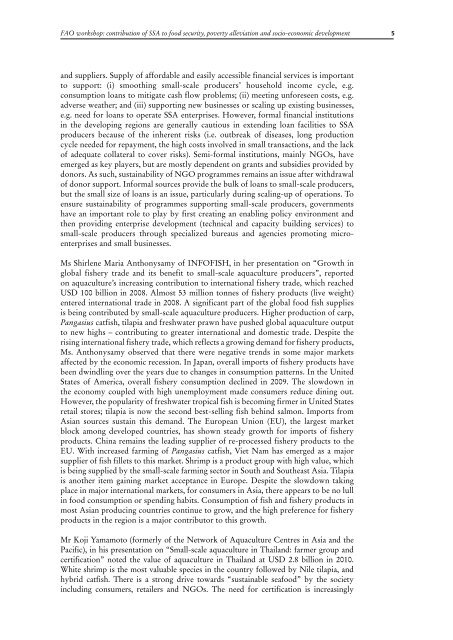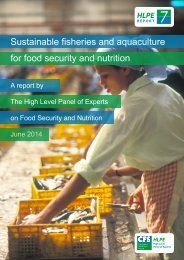BNZ6d
BNZ6d
BNZ6d
You also want an ePaper? Increase the reach of your titles
YUMPU automatically turns print PDFs into web optimized ePapers that Google loves.
FAO workshop: contribution of SSA to food security, poverty alleviation and socio-economic development5and suppliers. Supply of affordable and easily accessible financial services is importantto support: (i) smoothing small-scale producers’ household income cycle, e.g.consumption loans to mitigate cash flow problems; (ii) meeting unforeseen costs, e.g.adverse weather; and (iii) supporting new businesses or scaling up existing businesses,e.g. need for loans to operate SSA enterprises. However, formal financial institutionsin the developing regions are generally cautious in extending loan facilities to SSAproducers because of the inherent risks (i.e. outbreak of diseases, long productioncycle needed for repayment, the high costs involved in small transactions, and the lackof adequate collateral to cover risks). Semi-formal institutions, mainly NGOs, haveemerged as key players, but are mostly dependent on grants and subsidies provided bydonors. As such, sustainability of NGO programmes remains an issue after withdrawalof donor support. Informal sources provide the bulk of loans to small-scale producers,but the small size of loans is an issue, particularly during scaling-up of operations. Toensure sustainability of programmes supporting small-scale producers, governmentshave an important role to play by first creating an enabling policy environment andthen providing enterprise development (technical and capacity building services) tosmall-scale producers through specialized bureaus and agencies promoting microenterprisesand small businesses.Ms Shirlene Maria Anthonysamy of INFOFISH, in her presentation on “Growth inglobal fishery trade and its benefit to small-scale aquaculture producers”, reportedon aquaculture’s increasing contribution to international fishery trade, which reachedUSD 100 billion in 2008. Almost 53 million tonnes of fishery products (live weight)entered international trade in 2008. A significant part of the global food fish suppliesis being contributed by small-scale aquaculture producers. Higher production of carp,Pangasius catfish, tilapia and freshwater prawn have pushed global aquaculture outputto new highs – contributing to greater international and domestic trade. Despite therising international fishery trade, which reflects a growing demand for fishery products,Ms. Anthonysamy observed that there were negative trends in some major marketsaffected by the economic recession. In Japan, overall imports of fishery products havebeen dwindling over the years due to changes in consumption patterns. In the UnitedStates of America, overall fishery consumption declined in 2009. The slowdown inthe economy coupled with high unemployment made consumers reduce dining out.However, the popularity of freshwater tropical fish is becoming firmer in United Statesretail stores; tilapia is now the second best-selling fish behind salmon. Imports fromAsian sources sustain this demand. The European Union (EU), the largest marketblock among developed countries, has shown steady growth for imports of fisheryproducts. China remains the leading supplier of re-processed fishery products to theEU. With increased farming of Pangasius catfish, Viet Nam has emerged as a majorsupplier of fish fillets to this market. Shrimp is a product group with high value, whichis being supplied by the small-scale farming sector in South and Southeast Asia. Tilapiais another item gaining market acceptance in Europe. Despite the slowdown takingplace in major international markets, for consumers in Asia, there appears to be no lullin food consumption or spending habits. Consumption of fish and fishery products inmost Asian producing countries continue to grow, and the high preference for fisheryproducts in the region is a major contributor to this growth.Mr Koji Yamamoto (formerly of the Network of Aquaculture Centres in Asia and thePacific), in his presentation on “Small-scale aquaculture in Thailand: farmer group andcertification” noted the value of aquaculture in Thailand at USD 2.8 billion in 2010.White shrimp is the most valuable species in the country followed by Nile tilapia, andhybrid catfish. There is a strong drive towards “sustainable seafood” by the societyincluding consumers, retailers and NGOs. The need for certification is increasingly



